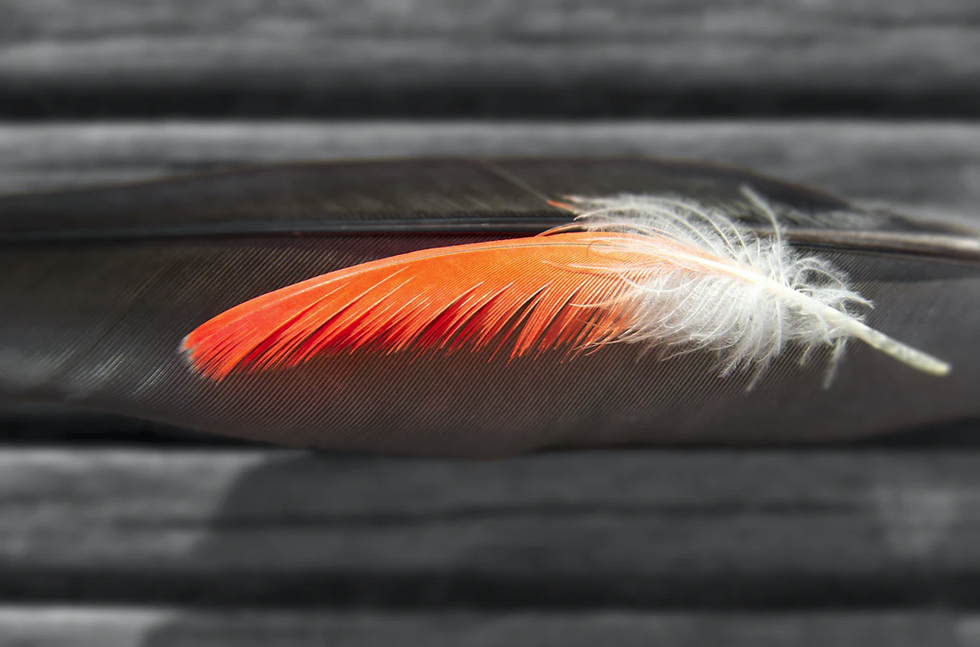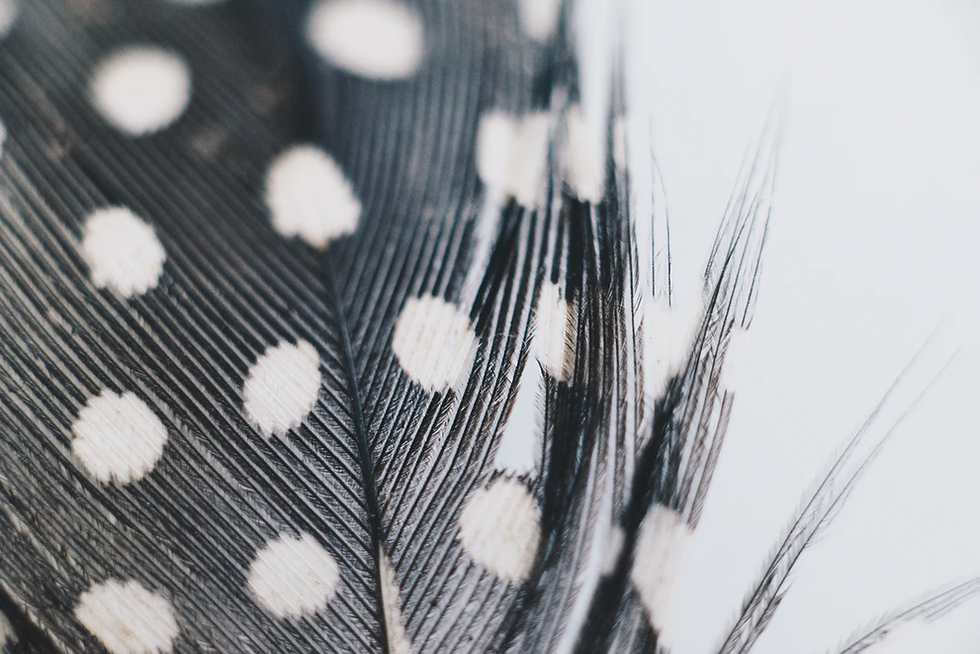Freaking Feathers
- Júlia Raíces
- Jul 13, 2021
- 6 min read
Updated: Sep 10, 2021
If you are close to a green area right now and you look outside you'll probably see or hear a bird. They are cute and fluffy IMO. They are also the group with the greatest number of different forms (species) between all things with bones (vertebrates) that walk the earth -or fly it in their case! And one of the reasons why there are so many bird species is the huge variety of feathers they can have. You probably already noticed that feathers can have a lot of different colours and that some birds can have a different plumage during the mating season - that is to make them look prettier to potential mates.
When we think of birds we think of feathers. And when we think of feathers we think of birds. After all, all birds have feathers, and only birds have feathers. But -besides being the defining characteristic of birds- what are feathers? Well, feathers are light hollow structures with barbs and barbules that create their cohesive structure. This might be easier to explain with a figure:


But that is the very basics. Feathers can be incredibly different from one another. Even within a single species or individual, the range of feather diversity can be amazing. Also, feathers have a lot of different functions, including but not limited to: hiding, showing off, communicating, flying, body temperature control, producing sound, and even water transport! But one of the best-known functions is attracting mates, sometimes in extravagant ways, such as the peacock's tail.
Besides making birds attractive to other birds coloured feathers can have other functions. Feathers might help with flight or make the bird waterproof, they can help hide from predators, or make the bird warm -they ruffle their feathers and look so fluffy! Look:

Feathers are also important to communicate to other birds, telling them for instance if they are old, healthy, and a variety of other things. They probably can even help keep bad organisms from themselves, helping keep the bird healthy. As I've said, feathers are probably one of the reasons birds can be in so many different environments.
But, we know things don't just appear when we need them -or in this case when birds needed them. So, what was there before feathers? Are birds the only organisms to ever have feathers? How did feathers start and how they came to be what we see and know nowadays?
To answer that, we first need to define what are feathers, after all, it is hard to determine when something evolved if we are not sure what that something is. So, feathers are structures that are light yet rigid. They are made of many small branches that hook into each other to guarantee the continuity of the feather. That can be hard to visualise but look at figure 3 to check it.


As you could probably guess feathers are the most complex appendage to grow from skin. And how they grow is also quite interesting, because, you see, feathers grow in tubular structures and the same follicle that grows one type of feather can grow any kind of feather and throughout a bird's life that usually happens.
Baby birds, for example, have very different feathers, called downy feathers. Those are used mostly to keep them warm. Wing feathers are also different as they are specialised for flying. And just like we have different types of hair in different parts of our bodies, birds have different types of feathers in different parts of their bodies. If you want to know more different types of feathers take a look at figure 4.

So far we talked a lot about bird feathers, but we now know some dinosaurs also had feathers! The first thing I want to say about it is dream-crushing, so please, brace yourselves. Unfortunately, we have evidence that the T-Rex and other big dinosaurs did not have feathers. I'm sorry to be the bearer of such terrible news. Take a deep breath, I promise it only get's better from here. So, first, there are some types of feathers that birds don't have and dinosaurs did! Even pterosaurs [which are not really dinosaurs] had feathers! And different types of feathers as well! And the raptors from the Jurassic Park franchise probably also had feathers, as the group they share with birds is the only one we know that had pennaceous feathers -f.y.i. the pretty feathers in quills are pennaceous. Even those pennaceous feathers are currently intertwined with birds and flying dinosaurs probably didn't use them for that purpose.
So, birds have feathers, some dinos had feathers. But most birds use feathers to fly, and dinos didn't. Than, what did dinos use their feathers for? and how they became specialised in flight? For a long time, those were questions without answers, but now we can tackle them with more information thanks to some fossils from northern China. Feathers are thought to have originated 80 million years before birds first appear in the fossil record. Feathers started as filamentous structures, not that different from hairs. But, unlike hairs, feathers diversified a lot so that by now we now of over 10 different types of feathers with different functions. Feathers likely evolved with endothermy -that is the ability to keep oneself warm and chill despite the variations of environmental temperature. And probably feathers helped to insulate the animal so it was easier to keep their internal temperature stable.
Downy feathers were also present in dinos. Down feathers are those fluffy ones newborn birds have that are used basically for insulation. In the beginning, those feathers were hollow and simple, and as they became more complex, so did their use. For example, there were dinosaurs with tail fans -those feathers that stand in the birds tail nowadays are also tail fans. And those tail fans were most likely used for display. The more time passed the more diverse and complex feathers became. With that feathers started being used for sexual display, that is to attract mates or intimidate potential competitors for said mate.
The use of feathers to attract mates or in a sexual context, in general, makes it under a new kind of selection: sexual selection. Sexual selection pressures can lead to the evolution and fixation of traits that are not beneficial or are even detrimental outside sexual selection -again, think about a peacock's tail. This allows for characteristics to evolve and change into a new function in a way that wouldn't be possible without it because the intermediate morphs are either detrimental or at least less beneficial than the initial morph. Unfortunately, we are still to find sexual dimorphism in fossil feathers, but the hypothesis is consistent, at least for now. We do know that currently birds' feathers are under sexual and non-sexual selection and that probably they were under both kinds of selection for a long time. The probable evolution of feathers started with simple filamentous feathers that evolved and were used for thermal regulation and insulation. Feathers then became branched but were still used mostly for the same purposes. The more complex feathers in the arms and tail of dinos were then also used for signalling and courtship. This step allowed for a bigger diversification of feathers into morphs that allowed for a new selective pressure as they could be used for parachuting and flight. And that's how feathers (probably) evolved and got to have such a big diversity.
The brings us to the variety of feathers birds have today. Feathers are still used for signalling and courtship, we can see amazing displays of it in species such as the birds of paradise. Currently, there are 7 types of feathers that can be either pennaceous or filamentous and can be used for anything from flight to insulation to sensory functions. Tail fans are still used for signalling and display as they are thought to have been when they first started differentiating.
This brings us to the end of this week's episode post. That was a lot. But we also learned a lot. So, let's review it.
Feathers are the most complex skin appendage in all land vertebrates! They are branched and complex hierarchical structures that have a wide range of functions, but started with a thermal regulation function only. From that initial filamentous structure, feathers were under sexual selection which means they had to be attractive to potential mates or signal their wearer's worth and keep competitors away. This "freedom" from functional constraints outside sexual selection allowed feathers to diversify to extreme morphs, which in its turn allowed feathers to be co-opted to new functions and structures. This instance shows us how sexual selection can be important for the evolution of structures and systems that later can be co-opted for functions that are not related to mating or other forms of sexual display. With this, I leave you to think about what else could have undergone such a path and how would you go about trying to find it out.
References:
Podcast episode:
Biology Fun and Facts - Episode 1:
Biologia Bar e Lanches - Episódio 1:






Comments